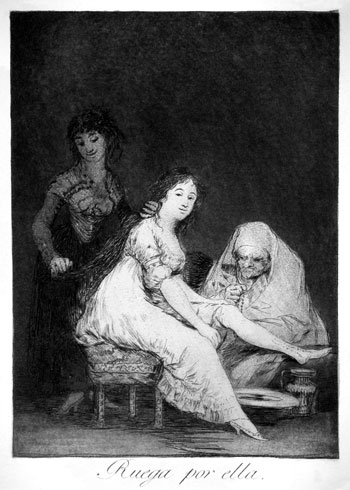Aquatint
The
Technique
The
preoccupation central to later 18th century
French printmaking of reproducing artists’ drawings
in facsimile also led to the invention
of aquatint as a means of achieving areas
of continuous tone in an etching similar
to the washes in an ink or watercolour
drawing. Until the 20th century aquatint
was nearly always used in conjunction with
the etched line.

Francisco
Goya (1746–1828):
"Ruega por ella"
(She prays for her). Etching and aquatint,
1799.
Plate 31 of the ‘Caprichos’. (205
x 151 mm)
The
principle method involves dusting a layer
of powdered resin onto the copper plate.
This can be done by hand but the plate
is more usually placed in a dust box. Bellows
raise a cloud of resin dust in the box
which is then allowed to settle as an even
layer over the plate. The resin is fused
in place by the application of gentle heat
from below. The artist stops out by painting
with acid-resist varnish those areas of
the plate which do not require tone. When
the plate is immersed in acid, the acid
can only bite around and in between the
exposed fused particles of resin, which
results in a fine network of lines, like
miniature crazy paving (see enlarged
detail of Manet, below right). The
size of the individual particles of resin
dust, whether coarse or very fine, determines
the grain of the aquatint. The length of
immersion in the acid controls the depth
of biting and hence the ‘depth’ (intensity)
of the resulting printed tone.
Two
other methods can be used to achieve an
aquatint ground, the spirit ground and
sugar-lift aquatint.
Spirit
Ground
In
spirit ground the powdered resin is dissolved
in alcohol and poured over the plate. The
alcohol evaporates and leaves the very
finely granulated resin on the plate, to
be treated as before. This method achieves
the finest grain of aquatint.
Sugar
Lift Aquatint
In
sugar-lift aquatint the artist draws his
design directly onto the untreated surface
of the copper plate with a brush and a
solution of india ink and sugar. The plate
is then covered with acid-resisting stopping-out
varnish. When set, the plate is placed
in warm water. The pure varnish ground
holds firm except where it covers the sugar-lift
drawing. The sugar solution slowly dissolves
in the water lifting the ground to expose
the copper. The exposed areas are then
dusted with resin and bitten in the usual
method of aquatint. Sugar-lift makes possible
a linear as well as a tonal treatment of
the plate in pure aquatint without the
usual adjunct of etched lines. As the bitten
image is created directly from the artist’s
brushstrokes on the plate it is a most
painterly technique (see enlarged
detail of Picasso).
History
of Aquatint
Jean
Baptiste Le Prince claimed the discovery
of gravure au lavis (literally “etching
with wash”), though in fact Jan van
de Velde IV in the 17th century had, untrumpetted,
anticipated him in isolated examples of
aquatint, and Le Prince’s contemporary
St Non was an equally early practitioner
of the technique. The tonal quality of
aquatint was also anticipated in the 17th & 18th
centuries by etchers such as Rembrandt
and Mulinari in their use of a sulphur
tint. Powdered sulphur, dusted over the
plate already thinly spread with oil, corroded
the surface so that it held ink as a uniform
tone in printing. Burnishing gave tonal
variations.
Le
Prince described the process of aquatint
for the first time in a paper to the French
Academy in 1768. Le Prince’s aquatints
were printed in sepia ink in imitation
of his sepia wash drawings which they sort
to emulate. In France the technique was
soon adapted to coloured inks printed from
multiple plates made by professional engravers
after paintings by the leading artists
of the day (see page on Colour
Intaglio).
Goya
(see above) was one of the few great artists
in the late 18th century to recognise the
potential of the medium for original printmaking.
The
term 'aquatint' was coined in 1776, by
Paul Sandby, to describe his invention
the previous year both of the spirit ground
technique and the sugar-lift method. (Today
the single word ‘aquatint’ suffices
for all the versions of the technique.)
English watercolour artists found the process
congenial both for creating original prints
(Sandby - see illustration, top right,
Thomas Malton, William Daniel &c.)
and for the reproduction of their topographical
and sporting watercolours by professional
aquatinters such as Stadler, Bluck, Sutherland,
Hill etc. who either etched the whole plate
or merely added aquatint tone to a plate
etched in line by the artist. The Swiss
also produced particularly fine reproductive
topographical aquatints at this period
when early tourists began to appreciate
the picturesque qualities of the Swiss
landscape. The reproductive aquatints of
the first half of the 19th century were
usually hand-coloured in the publisher’s
workshop to a model supplied by the originating
artist. Largely for economic reasons this
sort of aquatint was superseded by lithography
from about 1840.
Aquatint
enjoyed a limited revival from 1890–1940
as an artist’s technique. Picasso
particularly enjoyed using the sugar-lift
process (see illustration). |